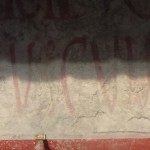Without question, one of my favorites of the Italian classic period painters is Raphaelo– and among all his works, my very favorite is The School of Athens, which hangs in the Vatican. On the way to the Sistine Chapel we went through the Raphael room… and here is what we saw. The ceiling in the hallway leading into the Raphael room is spectacular in its own right.

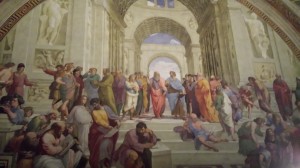
Then you turn the corner and see something even more astounding.
In case you don’t know the story of this painting, it represents the various sorts and schools of Greek philosophers, the central figures of course being Plato, Aristotle and Socrates. But just as interesting is the hommage that Raphael did to his contemporaries by portraying, for example Plato as having the face of Da Vinci. Here is a brief description of this painting…
“It was painted between 1509 and 1511 as a part of Raphael’s commission to decorate with frescoes the rooms now known as the Stanze di Raffaello, in the Apostolic Palace in the Vatican. The Stanza della Segnatura was the first of the rooms to be decorated, and The School of Athens the second painting to be finished there, after La Disputa, on the opposite wall. The picture has long been seen as “Raphael’s masterpiece and the perfect embodiment of the classical spirit of the High Renaissance.”
The parenthetical names are the contemporary characters from whom Raphael is thought to have drawn his likenesses.
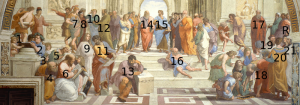
1: Zeno of Citium 2: Epicurus Possibly, the image of two philosophers, who were typically shown in pairs during the Renaissance: Heraclitus, the “weeping” philosopher, and Democritus, the “laughing” philosopher. 3: unknown (believed to be Raphael)[14] 4: Boethius or Anaximander or Empedocles? 5: Averroes 6: Pythagoras 7: Alcibiades or Alexander the Great? 8: Antisthenes or Xenophon or Timon? 9: Raphael,[14][15][16] Fornarina as a personification of Love[17] or Francesco Maria della Rovere? 10: Aeschines or Xenophon? 11: Parmenides? (Leonardo da Vinci) 12: Socrates 13: Heraclitus (Michelangelo) 14: Plato (Leonardo da Vinci) (Archimedes) 15: Aristotle (Giuliano da Sangallo) 16: Diogenes of Sinope 17: Plotinus (Donatello?) 18: Euclid or Archimedes with students (Bramante?) 19: Strabo or Zoroaster? (Baldassare Castiglione) 20: Ptolemy? R: Apelles (Raphael) 21: Protogenes (Il Sodoma, Perugino, or Timoteo Viti).
Here are a few close ups of the famous painting.
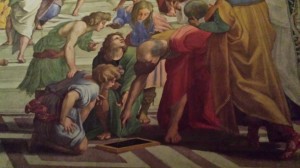
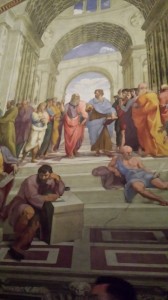
In case you were wondering the disgruntled figure in the foreground with the purple shirt leaning on a block of marble was one of Raphael’s heroes and contemporaries— Michelangelo.


